The year 2001 is one I’ll always remember for two trips, neither having anything to do with chess. The first one was a trip to Santa Fe, where I was scheduled to interview Stuart Kauffman for Discover magazine. This was a super exciting opportunity, as Discover was the highest-profile magazine I had written for yet and Stuart Kauffman was a very high-profile scientist. I flew to Santa Fe on September 10 and arrived at the office of Kauffman’s company the next morning, primed and ready to go. The first words the receptionist said to me were: “Have you heard?”
I went ahead and did the interview with Kauffman anyway, and I was strangely glad of it because it gave me something else to think about than the awful tragedy in New York. However, I couldn’t fly back to California as planned, because all planes in the U.S. were grounded, and instead I had to drive my rental car all the way from Santa Fe to San Jose.
That was an amazing drive. I stopped off at Meteor Crater and the Lowell Observatory in Flagstaff, where Pluto was discovered. Everywhere I went, total strangers were talking with each other: in hotels, at gas stations, at the visitor center at Meteor Crater. They wanted to share their stories and find out the latest news. The radio stations were playing songs I had never heard before — “America the Beautiful” by Ray Charles, for example. It was a transcendent shared experience, and in retrospect it was the last time I can remember feeling as if all Americans were united together against a common threat. The pandemic of 2020 should have brought us together the same way, but in case you didn’t notice, it didn’t.
My second memorable trip was to London, England, at Thanksgiving. It was the first trip I’d taken since 9/11, and also my first trip with Kay to England since our honeymoon twelve years earlier. We had a great week, renting a flat in Covent Garden. During the day I would go to Cambridge, where I was doing research for my first book, reading the letters of Charles Darwin and his family. What an amazing experience, to read 125-year-old letters that might in some cases have been unread for more than a century! In the evening we would go to plays (“Starlight Express”) or movies (the first Harry Potter movie had just come out).
In chess, 2001 was not such a remarkable year for me. But there was one unique thing about it. It was the only year when I kept a notebook not only of my rated tournament games, but also my (unrated) chess club games. Each week I would play three 25-minute games. I didn’t keep score, but after I got back home, if I had played one or two interesting games, I would quickly write down the moves before I forgot them. At the end of 2001, for some reason, I quit doing this, maybe because I wasn’t actually seeing any improvement in my chess. Because this was the only year when I have a record of my chess club games, it makes sense to feature one of them in this post. Actually, I will feature two, because the first one is super-short.
My opponents were the two other strongest players in the club at the time, and therefore the people I played the most often: Ilan Benjamin and Steve Sullivan. Their styles were incredibly different. Steve was, in a word, a hustler with a hustler’s mentality. He was much more interested in playing mind games against the opponent than chess games. I won’t go into the various psychological tricks he tried to use, because they were mostly very trite, but in the pure chess sense, part of his schtick was playing the Grob (1. g4) or the Borg (1. … g5), in almost every game. They are the ultimate unconventional openings, but they are unconventional in such a conventional way that when you run into someone who plays the Grob, you actually already know a great deal about him.
Unlike Steve, Ilan was always a good sportsman and a complete gentleman. He had a respectable job, a professor at the University of California at Santa Cruz; Steve, as far as I knew, was a street person with no discernible source of income. Ilan talked about his family often; Steve never mentioned having a family. As if to reflect his respectable situation in life, Ilan played respectable chess: the most solid openings, the soundest strategy.
By any reasonable standard Ilan was a better player, but Steve was like his kryptonite. Ilan just couldn’t fathom the crazy things that Steve did, and could never find his “comfort zone” against him. On the other hand, I enjoyed playing both of them as a challenge. I tried to meet Steve’s crazy chess halfway, and I tried to find the hidden flaws in Ilan’s correct chess. But there was definitely a bit of whiplash playing both of them in the same night.
Here is a pair of games I played against them on the same night: January 2, 2001. You’ll see what I mean.
Dana Mackenzie — Steve Sullivan, 1/2/2001
1. e4 g5 2. d4 g4
Steve rotated between three second moves, 2. … Bg7 (which seemed to be his favorite), 2. … h6, and this one. I’ll leave it to Grob theorists (I’m sure they are out there) to decide which is best.
3. Qxg4 …
Embracing the craziness. But the computer says that 3. Nc3 is better.
3. … d5 4. Qh4 de 5. Nc3! …
Chess is a battle for the initiative. I have no interest in holding onto the pawn with 5. Qxe4 Nf6, because it hands the initiative over to Black.
5. … Qxd4 6. Nf3 …
Now it’s White who has the initiative, developing pieces rapidly and chasing Black’s queen around.
6. … Qf6 7. Bg5 Qb6
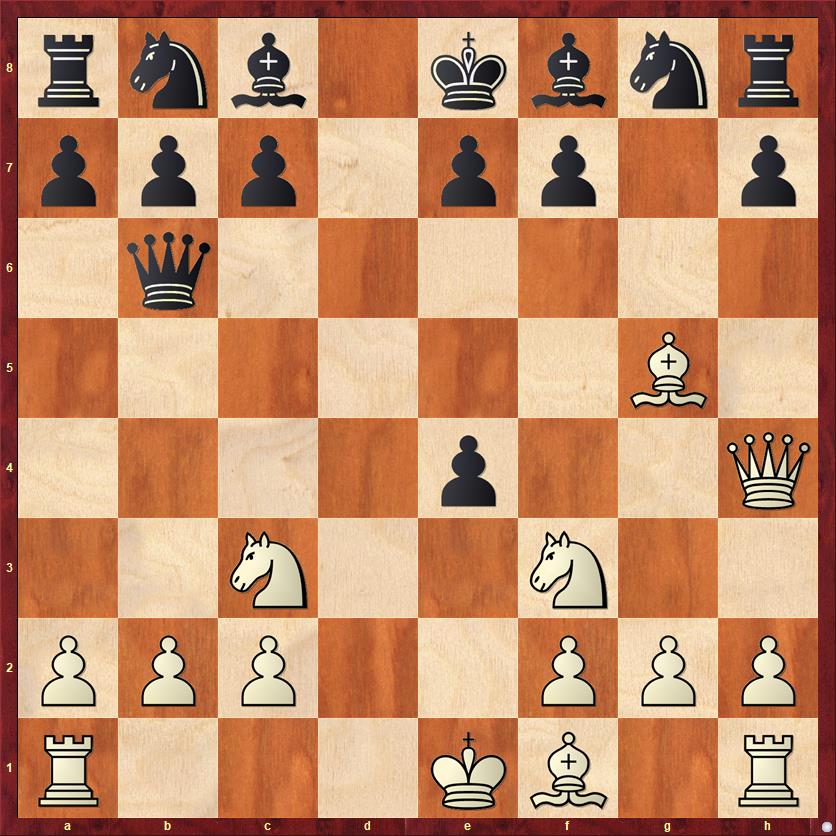
FEN: rnb1kbnr/ppp1pp1p/1q6/6B1/4p2Q/2N2N2/PPP2PPP/R3KB1R w KQkq – 0 8
It looks as if White may have gotten in too deep — he’s a pawn down, with another pawn and a piece hanging. On the other hand, White is unbelievably far ahead in development, with four pieces developed to Black’s one. Might as well develop a fifth piece!
8. O-O-O! Bg7
An interesting decision, because it’s not completely obvious how White wins after 8. … ef. In fact, my postgame analysis of this variation was a little bit flawed. I intended to play 9. Nd5, and after 9. … Qa5 I thought that 10. Bf4 was the best move. I missed 10. Qa4+!!, a beautiful and thematic deflection that wins Black’s queen on the spot (because 10. … Qxa4 11. Nxc7 would be mate).
Likewise, on 8. … ef 9. Nd5 Qc5 I overlooked the immediately winning variation 10. Qb4! (again the deflection theme!) Qd6 11. Qc3! and instead analyzed the inaccurate 10. b4 Qd6 11. Bf4? I missed Black’s saving move, 11. … Bh6! Finally, in my notebook I didn’t even analyze Black’s third reasonable move after 8. … ef 9. Nd5, namely 9. … Qd6. The computer then says White’s should play 10. Qg3! The only reasonable way for Black to defend the c7 pawn is to block my queen’s diagonal with 10. … e5 (diagram). Can you see how White wins here?
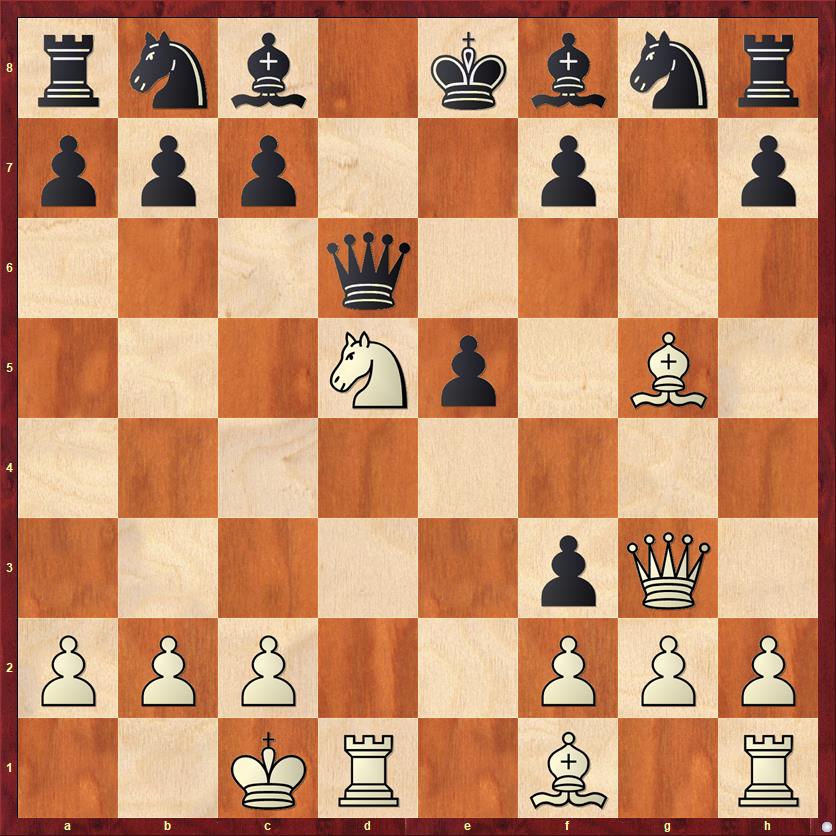
FEN: rnb1kbnr/ppp2p1p/3q4/3Np1B1/8/5pQ1/PPP2PPP/2KR1B1R w kq – 0 11
Congratulations if you found the following devastating combination: 11. Nxc7+! Qxc7 12. Qxe5+!! Qxe5 13. Rd8 mate. It’s truly a fitting punishment for Black’s failure to develop any of his pieces, aside from his queen.
I didn’t see all of these queen sacs when I was at the board, and probably Steve didn’t either. But the scent of checkmate was definitely in the air, and I think we both perceived it. So he chose a developing move instead of taking my knight.
Now, back to the game:
9. Qxe4 Bxc3?!
I criticized this in my notes: “Black gives away the dark squares too easily.” I thought that 9. … Nf6 or 9. … Nc6 would have been better. But Black’s position has problems that won’t be solved easily, especially the problem of his king being caught in the center.
10. bc Qa5??
Keep in mind, this is 25-minute chess. Blunders happen. Again, Black should try to develop some pieces with 10. … Be6 or 10. … Nc6, but he is in trouble either way.
11. Qd4 …
Threatening both checkmate and the h8 rook. The game is over.
11. … Qa3+ 12. Kb1 Nc6 13. Qxh8 e6 14. Qxg8+ Black resigns
Well, that game was over too soon, so let’s look at another one, shall we? In my third game that same night, I also got another nice “gift.” But this one was way more subtle.
Dana Mackenzie — Ilan Benjamin, 1/2/2001
1. d4 c5 2. c4 e6 3. Nc3 Nf6 4. Bg5 Be7 5. e3 h6 6. Bh4 O-O 7. cd Nxd5 8. Bxe7 Qxe7 9. Bd3 Nxc3 10. bc c5 11. Nf3 Nc6 12. O-O Rd8 13. Be4 …
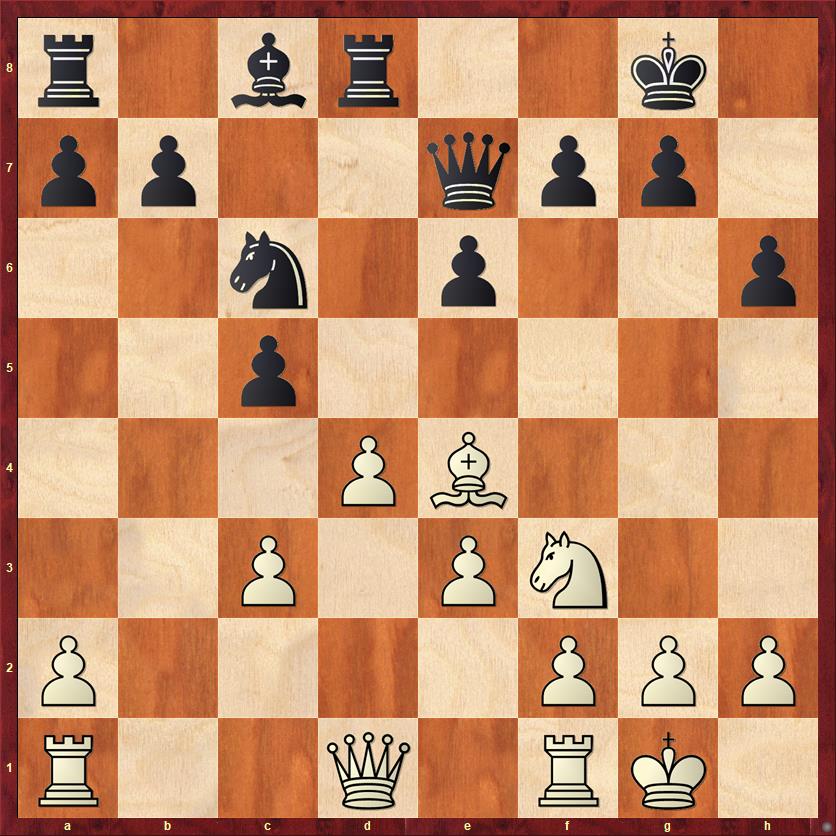
FEN: r1br2k1/pp2qpp1/2n1p2p/2p5/3PB3/2P1PN2/P4PPP/R2Q1RK1 b – – 0 13
So far there hasn’t been very much to say. A pretty standard Queen’s Gambit Declined, and my last move was the first one that seemed even a little bit adventurous. On ChessBase, the first occurrence of this position was a game between Igor Zugic and Igor Ivanov, Canada championship 2004. My game was three years earlier! I’m not sure if I really believe ChessBase, though. This position could easily have occurred in the 1910s or 1920s or 1930s but not made it into their database.
Unlike IM Ivanov, Ilan decides to trade pawns. That makes control of the c-file a very important theme in the position.
13. … cd 14. cd Bd7 15. Rc1 Rac8 16. Qd2 Be8 17. Qb2 b6 18. Rc3 Nb4 19. R1c1 …
This is consistent with my plan, but there’s a tactical reason why it might be a slight misstep. See next note.
19. … Rxc3 20. Rxc3 Nd5
Black misses an interesting tactical possibility, based on White’s suddenly weakened back rank: 20. … e5!?, when 21. Nxe5? walks into 21. … Qxe5!, when White can’t take because of mate on the back rank. Instead White has to retreat with 21. Rc1, which looks pretty drawish to me after 21. … ed 22. Nxd4 Qxe4 23. Qxb4. Black has a bishop (which has been “cured” of bad bishop syndrome) against a knight, but my knight has a perfect outpost on d4.
21. Bxd5 Rxd5 22. h3 Rb5?
The first real turning point in the game. Black plays in a superficially active way, but it’s not clear what future the rook has on the b-file. Meanwhile, White is given uncontested control over the c-file.
23. Qc2 g6 24. Ne5 …
All of a sudden, all of White’s pieces are better than their Black counterparts.
24. … a5 25. Rc8 Kg7 26. Rc7 Qf6
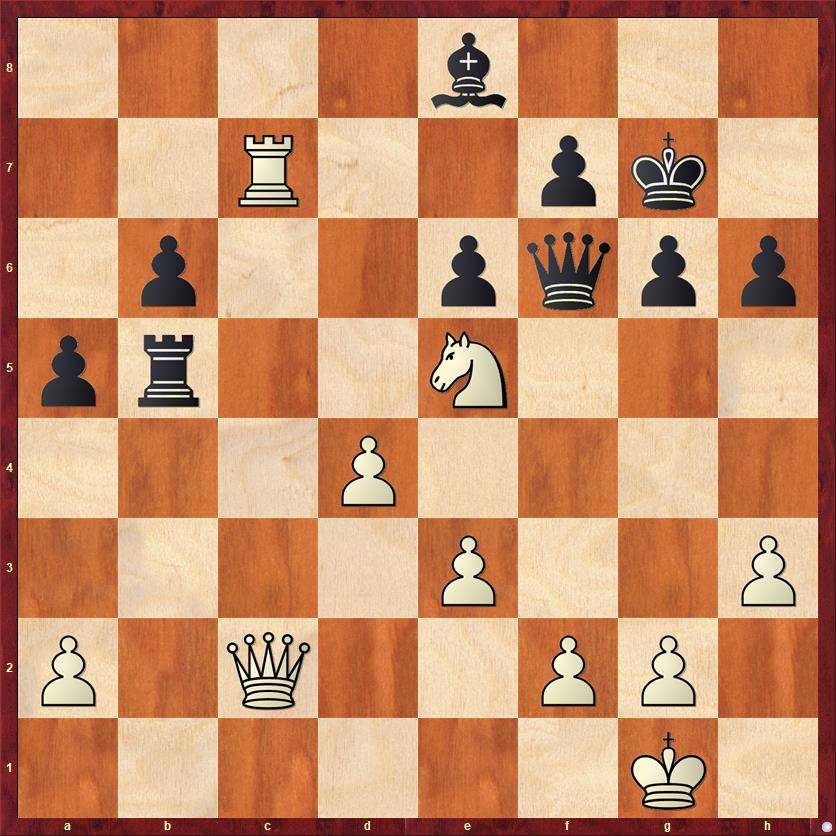
FEN: 4b3/2R2pk1/1p2pqpp/pr2N3/3P4/4P2P/P1Q2PP1/6K1 w – – 0 27
This is an interesting moment strategically. All of Black’s pieces are in pretty awkward positions: the rook on b5, standing in the way of his pawn and not able to make any effective threats; the queen on f6, tethered to that square because of my threat of Qxg6+! if it leaves; and the sad bishop on e8, condemned to purely passive defense of f7.
But the question is: how can White increase his advantage? I came to the conclusion that my queen needed more activity; on c2 she plays merely a supporting role. She would really like to be on the seventh or, even better, the eighth rank. But how to get her there?
The only possibility that I wrote down in my notebook was 27. Qe4, which must have been my first choice. But I concluded this was no good, giving the variation “27. … Qf5! 28. Qa8 Rb1+ 29. Kh2 Qxf2! 30. Qxe8 Qg1+ leading to a perpetual.”
Well, thanks to the computer I know that this analysis is just wrong. In fact, if we continue the above line with 31. Kg3 Qe1+ (31. … Qxe3+? 32. Nf3 would end the checks right away) 32. Kf4 Qh4+ 33. g4 Rf1+ 34. Ke4! (not 34. Nf3? Qf6+ and Black wins) White escapes the checks and wins very soon thereafter.
In a quick time control where I was probably down to 5 or 10 minutes on my clock, this would have been a really tough calculation that would require nerves of steel. I have to see eight moves deep and even on the eighth move, if I make one misstep I lose. Anyway, I didn’t see that deep, so I concluded that 27. Qe4 didn’t work. So then I looked at ways in which I could perhaps prepare that move. It occurred to me that the weak pawn on f2 was my Achilles’ heel in the above variation. If I pushed it to f4, then I could threaten 28. Qe4 on the next move. However, the flaw in my thinking was that Black doesn’t have to sit around and wait for that.
With a little bit more time, maybe I could have returned to my original idea: How can I make my queen more active? If 27. Qe4 doesn’t work, is there another way? The computer comes up with a very simple solution: 27. Rb7! This move is useful anyway because it attacks the b-pawn and guarantees that I will win a pawn if Black tries to bring his rook back onside with … Rd5. Meanwhile, it clears the c-file for my queen to go to c8. A sample, and not very difficult, computer variation is 27. Rb7! Qf5 28. e4 Qf6 29. Rb8 Qe7 (not 29. … Kf8?? 30. Nd7+) 30. Qc8 winning the bishop.
27. f4? …
As explained above, this was a logical move but not best. The main problem with it is Black’s next move.
27. … Qf5!
And now 28. e4? would be met by 28. … Qxf4! Pawn advances always create weaknesses.
28. Qxf5? …
Another major decision, after which White’s advantage evaporates.
I feel as if one of my greatest weaknesses in chess is that I’m always too willing to trade queens. And that was the case here, where it’s the activity of my queen, knight, and rook working together that gives me winning chances. Once the queens come off, Black’s rook is no longer shackled to b5 and can start doing serious damage to White’s queenside. So I should have done anything to keep queens on. And 28. Qc3! is a very tempting move, placing the queen on the same diagonal as the king and creating lethal discovered check threats.
Still, this move too would have required precise calculation and nerves of steel. Black can gobble up the a-pawn with 28. … Qb1+ 29. Kh2 Qxa2. But now White can set up his discovered check with 30. d5!, and there is no good way for Black to defend. If 30. … Qb2 now White is happy to trade queens, because 31. Qxb2 Rxb2 32. de is completely winning. Alternatively, if Black tries to trade queens more quickly with 28. … Qb1+ 29. Kh2 Qb2, White continues to spurn the trade with 30. Qc4! Rd5 31. Re7! and Black’s beleaguered forces finally reach the breaking point. After 31. … Kf8 32. Qc7 or 31. … Qb5 32. Qxb5 Bxb5 33. Rxf7+ Black’s position collapses like a house of cards.
Especially at a rapid time control, I’m not sure how much you can rely on seeing all of these tactics. Here’s where I think that intuition and self-confidence have to play a role. In the Steve Sullivan game, I had the confidence to sacrifice a piece, even if I didn’t completely see all the details of how I would win. In this game, I should have had the confidence to keep the queens on the board, in the belief that something good would have to turn up because Black’s pieces were in such awkward positions. But I didn’t, and so I let Ilan back into the game.
28. … gf 29. Rc8 Rb1+ 30. Kh2 Kf8
After the game I thought 30. … Bb5, activating the bishop, would have been a better choice, but the computer says that this move also equalizes.
31. Rb8 Ke7 32. Nc4 b5 33. Rb7+! Kf6?
Very surprisingly, this natural-looking move gets Black into hot water. The reason is that his bishop is forced away from the defense of f7, and then the king finds himself in a near mating net. According to the computer, Black had to play the unappealing but correct 33. … Kd8! After 34. Nxa5 Re1 wins back the pawn. And on the very dangerous-looking 34. Nd6, Black just starts pushing his pawns with 34. … a4. If I chase pawns on the kingside with 35. Nxf7+ or with 35. Rb8+ Kc7 36. Rxe8 Kxd6, Black’s queenside pawns will be on top of me before I realize it.
What a crazy, illogical game chess is! Nine times out of ten, … Kf6 would be the right move. But the tenth time, it is the wrong move.
34. Nd6! Bc6 35. Rxf7+ Kg6
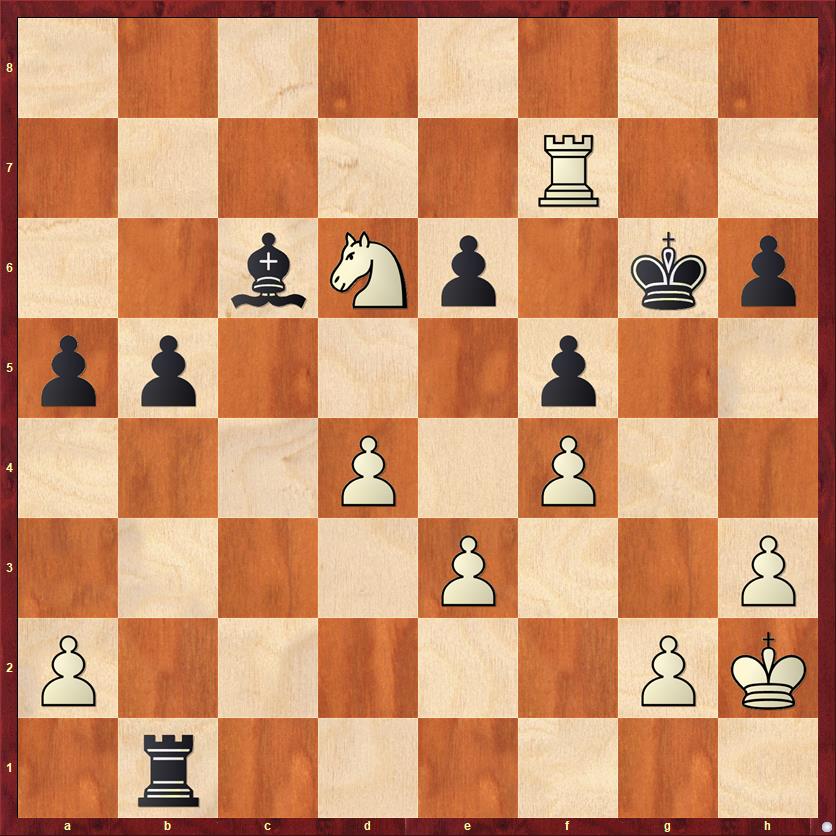
FEN: 8/5R2/2bNp1kp/pp3p2/3P1P2/4P2P/P5PK/1r6 w – – 0 36
36. Rc7?! …
In a ferociously difficult endgame, the computer says this is a mistake. But I can’t possibly give it a full question mark. The computer says 36. Re7! is correct, with the idea of answering 36. … Bd5 with 37. e4!! But seriously, how many humans can play this way? I have no idea who’s winning after 37. … Bxa2. And as if that’s not enough, there are also head-spinning complications after 36. Re7 Rb2 37. Rxe6+ Kh7 38. Kg3! Rxg2+ 39. Kh4. And furthermore, an incredibly important point after 36. Re7 is that 36. … Kf6 is answered by 37. Rc7! Why, you will ask, is this move incorrect on move 36 but correct now? The answer is that I have suckered Black’s king to the wrong square, f6, so that after 37. … Bd5 I can play 38. Ne8+ WITH CHECK and catch him in a mating net: 38. … Kg6 39. Rg7+ Kh5 40. Nf6+ Kh4 41. g3 mate!
I mean, seriously, chess is too hard for humans. I was surely under 5 minutes on my clock by now. How am I supposed to see a move whose main point is to lose a tempo in order to set up a four-move checkmate, and at the same time accurately evaluate all of these subsidiary lines that involve berserk pawn sacrifices and pawn races and fire all over the board?
I doubt that I even looked at 36. Re7. After all, why play Rc7 in two steps when you can do it in one step? See my above comments about the logical move not always being the best!
One lesson I draw from this game is that you don’t have to play crazy openings, like Steve Sullivan and his Grob Opening and Borg Defense. You can play staid, mainstream openings like the Queen’s Gambit Declined, and the craziness of chess will still find you. Sooner or later. Whether you’re expecting it or not. And that’s a good thing!
36. … Bd5 37. Ne8 …
It’s not check, which gives Black one chance to get out of the mating net…
37. … Rb2??
And Black misses the chance! Of course he must have thought this move was good enough to win. The a-pawn is hanging, and the g-pawn is hanging with a dangerous check. None of this matters, though, because Black’s king is in a mating net.
The only move for Black was 37. … h5!, with a draw by repetition after 38. Rg7+ Kh6 39. Rg5! Bxa2 40. Nf6 followed by Ng8+. White is quite glad, actually, to get a draw by repetition because otherwise Black’s armada of queenside pawns would be decisive.
38. Rg7+ Kh5 39. Nf6+ Kh4
I’m sure that Ilan saw this far and thought he was okay because my g-pawn is pinned, so I can’t play 40. g3 mate as in the previous variation. But what happens to him is a slow-motion version of the previous mate.
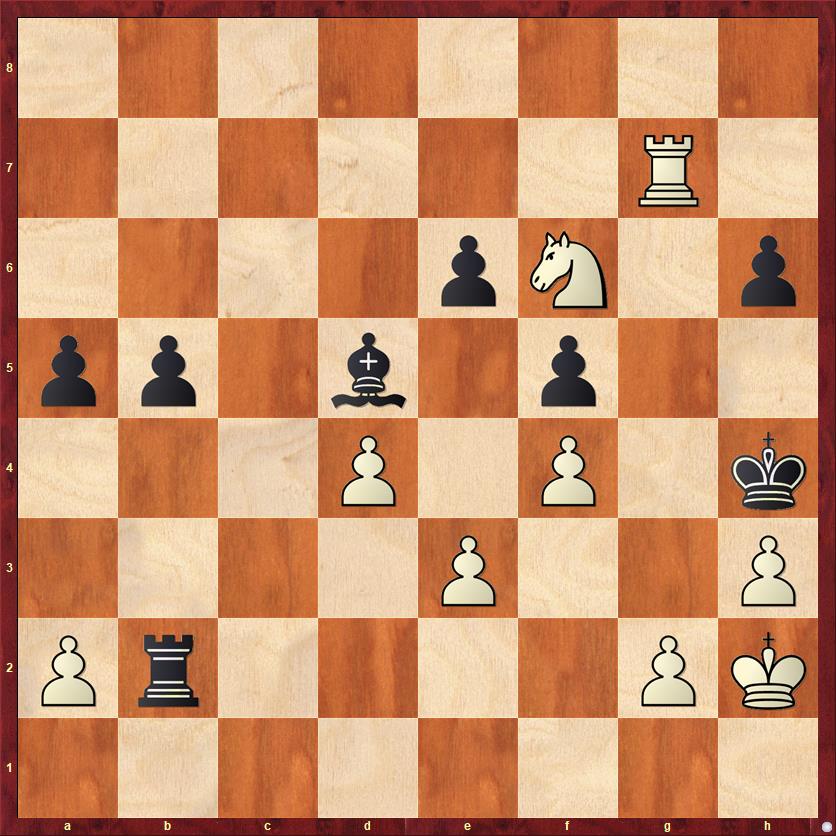
FEN: 8/6R1/4pN1p/pp1b1p2/3P1P1k/4P2P/Pr4PK/8 w – – 0 40
40. Rg6 h5
“Closing the coffin,” I wrote in my notebook. Black could have avoided the checkmate with 40. … Rxg2+, but the endgame is still lost.
41. Rg5 Rxg2+
If 41. … Bf3 White would proceed exactly as he did in the game with Nd7, Ne5, etc.
42. Rxg2 Bxg2 43. Kxg2 b4 44. Nd7 a4 45. Ne5 …
Black cannot stop what is essentially a smothered mate with 46. Ng6 mate. Black resigns.
What a battle! I felt as if Ilan actually outplayed me strategically, but I was saved by a last-minute knockout punch using the only minor piece I had left on the board. After this game I switched to playing only 1. e4 when I played White against him, hoping to get sharper positions with more tactics. I apparently succeeded, because in our games that year I compiled 17 wins, 5 losses, and 5 draws for a 72 percent winning rate.
Because this is probably the last entry I will write about the Santa Cruz chess club, there’s one more story I want to tell. In its final years, when the club met at Borders bookshop, there was an older woman, maybe 60-ish, who came pretty regularly but never played. This was already a little bit surprising, because you don’t see a lot of women in chess clubs anywhere, and especially not older women. She also had a somewhat unusual appearance, but this just meant that she was normal for Santa Cruz. I particularly remember her rat’s nest of disheveled hair. But it wasn’t even the most unusual hairstyle at the chess club: Steve Sullivan never went anywhere without wearing a jester’s crown on his head.
Months went by and I never talked with the mystery woman. She wouldn’t play, she would just sit (or stand) and watch. Mostly she watched my games. Ronee, the other female player at the Borders club, noticed this after a while, and chatted her up at one point. She asked her why she liked to watch my games, and the woman answered that my games looked to her like art!
I was deeply honored by this compliment but I still never talked with the mystery woman. Especially after Ronee reported this to me, I would have felt awkward striking up a conversation. Eventually the Borders club shut down, but I still continued to see Ronee because she helped me at the Aptos library chess club. One day a few years later, maybe around 2008 or 2009, she asked me if I still remembered the mystery woman. I said, of course. She told me that she found out that the woman had died of a heart attack, and it turned out that the woman… wasn’t a woman! Her name was John.
It’s interesting that back then, this was still a shocking revelation. But it also explained a lot. It explained the woman’s reticence. It explained her rat’s nest hairdo, the coarse texture of her hair and the coarse (as I realized in retrospect, though I hadn’t verbalized it before) texture of her skin. It even explained her heart attack, because men die of heart attacks more often than women do.
At the time, I thought of it as an “only in Santa Cruz” thing. But gradually, I’ve started to see that it’s an “everywhere” thing. More and more non-binary people are trying to live more or less openly in the world. For every one of them it’s a struggle, and each one finds their own level of openness and their own level of courage. John was able to go just so far, and no farther. She couldn’t reveal her secret, but she could go to chess club and enjoy watching the games. That’s the one thing that she shared with all of us.



{ 3 comments… read them below or add one }
Thanks for this column. I appreciate the insights into life beyond chess.
I like the idea “that the craziness of chess will still find you” regardless of what openings you play. I recall one of my most exciting correspondence games that started out in a Symmetrical English, which was indeed perfectly symmetrical after about a dozen moves. But things diverged at that point, and the resulting complications seemed all the more intricate for the game having been a late bloomer.
Can I borrow about half of your over-willingness to trade queens? I had a lovely game vs. an Expert which I spoiled because I failed to realize that Black needed his queen for his counterattack, whereas I could still attack without mine. I kept them on, and his counterattack burst through. It’s a serious blind spot that I am trying to work on.
LOL! Yes, let’s trade. I think that it started with me enjoying the challenge of trying to win with queenless attacks, and it gradually moved into the territory of trading queens even when I shouldn’t. Also, one of my favorite opponents in North Carolina, Bernie Schmidt (did you know him?), really hated to trade queens, and sometimes would play an inferior variation just to avoid a queen trade. I’m pretty sure that we had a Budapest Gambit game one time that started 1. d4 Nf6 2. c4 e5 3. de Ng5 and I played 4. e6! This move is harmless if Black plays 4. …de and allows a trade of queens, but I was pretty sure that Bernie wouldn’t do that. For him the move 4. … fe was “psychologically forced,” and then White gets an advantage, in my opinion.